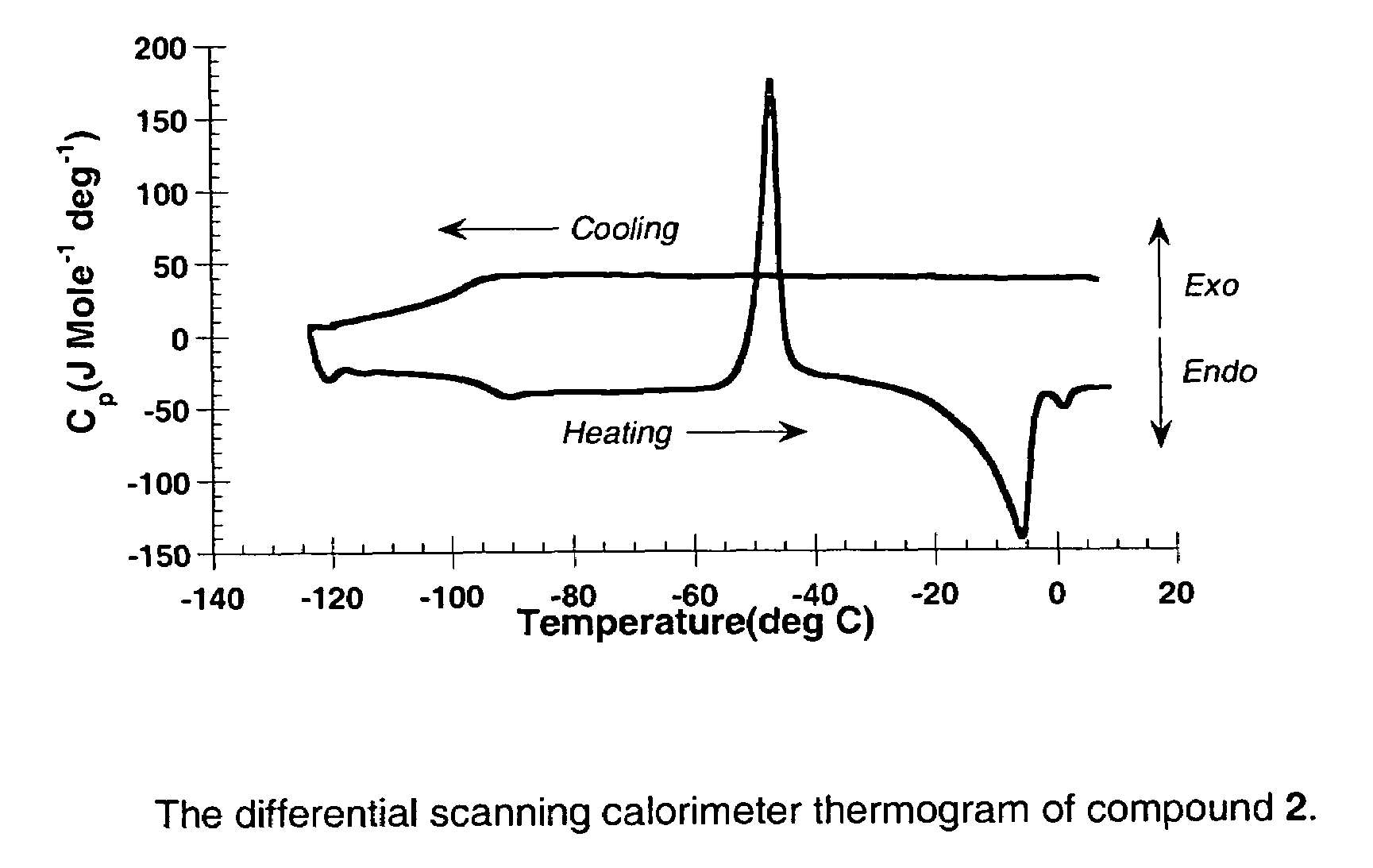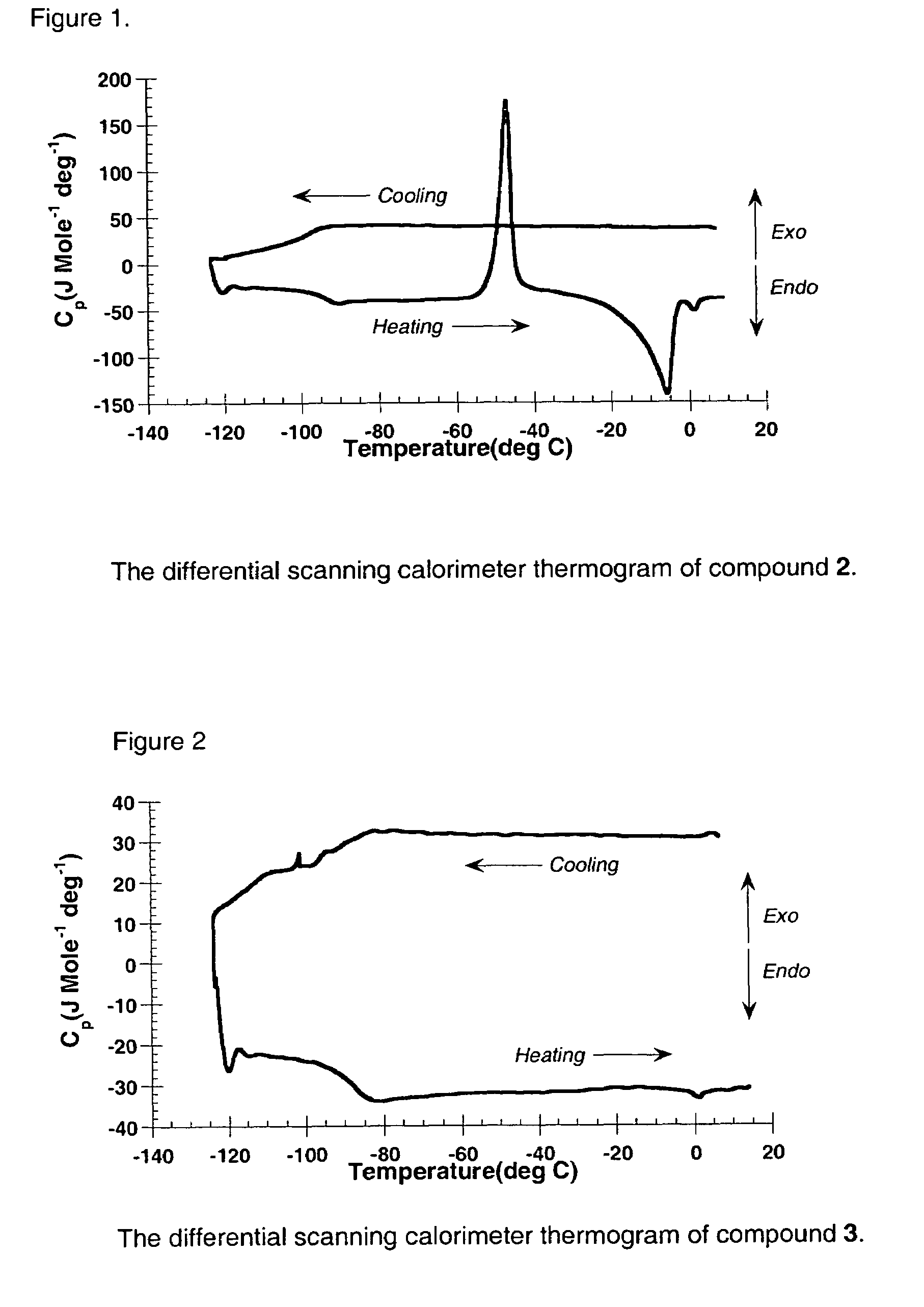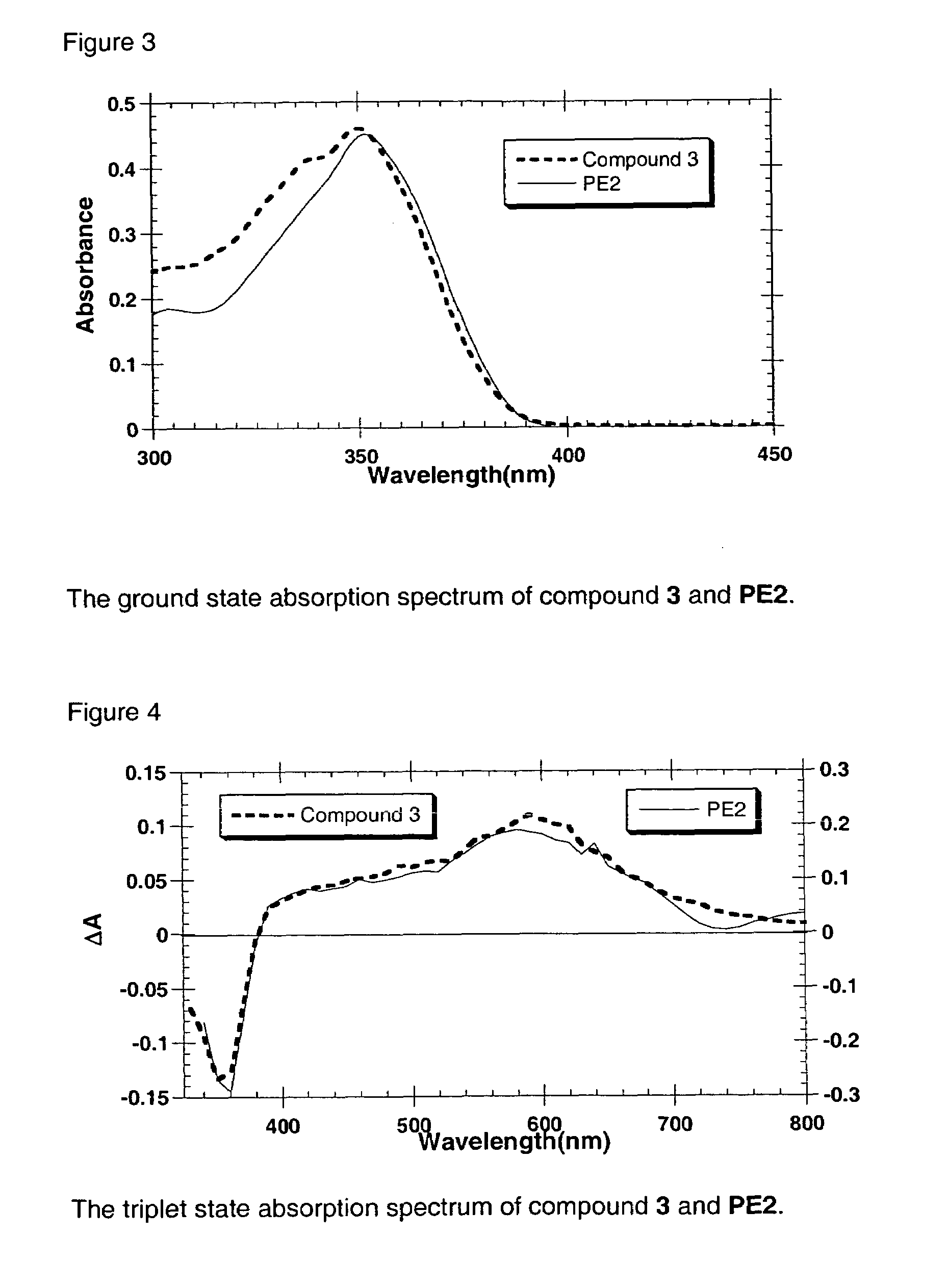Liquid transition metal acetylide chromophores
a transition metal and chromophores technology, applied in the field of nonlinear optics devices, can solve the problems of preventing the study of high concentration solutions of pe2 and related, and the device performance is decreasing, and achieves the effect of high chromophores and low viscosity
- Summary
- Abstract
- Description
- Claims
- Application Information
AI Technical Summary
Benefits of technology
Problems solved by technology
Method used
Image
Examples
example 1
Synthesis of PtCl2(POct3)2
[0053]To a solution of K2[PtCl4] (2000 mg, 4.84 mmol) in water (50 ml) trioctylphosophine (4313 μl, 9.68 mmol) was added and the resulting solution left to stir at room temperature for 2 days giving a yellow sticky solid. Dichloromethane (30 ml) was added and the organic layer separated. Removal of the solvent gave a yellow liquid, which crystallises upon cooling. Identified as a mixture of cis- and trans- PtCl2(POct3)2 1 (3000 mg, 62%). MA: found C, 57.54; H, 10.08. C48H102Cl2P2Pt. requires C, 57.24; H, 10.21%. Mw=1005. 1H NMR (CDCl3): 80.88 (m, 3H, CH3), 1.25 (m, 8H, CH2), 1.38 (m, 2H, CH2), 1.52 (m, 2H, CH2), 1.95 (m, 2H, CH2) ppm. 13C NMR (CDCl3): δ 14.30 (s, CH3), 22.85 (s, CH2), 24.38 (t, J(CP)=17 Hz, CH2), 24.70 (s, CH2), 29.41 (s, CH2), 29.45 (s, CH2), 31.30 (t, J(CP)=7 Hz, CH2), 32.05 (s, CH2) ppm. 31P NMR (CDCl3): δ 2.08 (s, J(PPt)=3515 Hz, cis-POct3), 5.75 (s, J(PPt)=2378 Hz, trans-POct3) ppm. El MS: (m / z) 1005, [M]+; 935, [M-2Cl]+; 407, [Cl.P(C...
example 2
Synthesis of Pt(C≡CPh)2(POct3)2
[0054]To a microwave cell, PtCl2(POct3)2 (500 mg, 0.50 mmol), HC≡CPh (137 μl, 1.24 mmol), Cul (19 mg, 0.1 mmol) and NHEt2 (10 ml) were added and heated for 10 minutes at 150 W [˜48 PSI]. After this time the solution was pale green and the white precipitate of NH2Et2Cl was seen. Solvent was removed, residue dissolved in CH2Cl2 and purified on alumina, elution with hexane gave a pale yellow fraction, which gave an oil upon removal of solvent. Identified as Pt(C≡CPh)2(POct3)2 (512 mg, 90%). MA: found C, 67.58; H, 9.96. C64H112P2Pt requires C, 67.51; H, 9.91%. Mw=1137.79. 1H NMR (CDCl3): δ 0.89 (m, 3H, CH3), 1.27 (m, 8H, CH2), 1.42 (m, 2H, CH2), 1.60 (m, 2H, CH2), 2.16 (m, 2H, CH2), 7.10-7.29 (m, 5H, ArH) ppm. 13C NMR (CDCl3): δ14.38 (s, CH3), 22.94 (s, CH2), 24.38 (t, J(CP)=17 Hz, CH2), 24.48 (s, CH2), 29.51 (s, CH2), 31.59 (t, J(CP)=7 Hz, CH2), 32.16 (s, CH2), 108.28 (t, J(CP)=15 Hz, Pt—C≡C), 109.20 (s, Pt—C—C), 124.98 (s, ArH), 128.01 (s, ArH), 129.35 ...
example 3
Synthesis of Pt(C≡CC6H4C≡CPh)2(POct3)2
[0055]To a solution of PtCl2(POct3)2 (200 mg, 0.20 mmol) and HC≡CC6H4C≡CPh (100 mg, 0.50 mmol) in a mixture of piperidine (5 ml) and toluene (10 ml), Cul (4 mg, 0.02 mmol) was added and stirred at room temperature for 16 hours. Solvent was removed and the residue was dissolved in CH2Cl2 and purified on alumina, elution with hexane gave an orange-yellow fraction, which gave an orange-yellow oil upon removal of solvent. Identified as Pt(C≡CC6H4C≡CPh)2(POct3)2 (454 mg, 85%). MA: found C, 71.78; H, 8.80. C80H120P2Pt requires C, 71.77; H, 9.03%. Mw=1337.85. 1H NMR (CDCl3): δ 0.90 (m, 3H, CH3), 1.28 (m, 8H, CH2), 1.43 (m, 2H, CH2), 1.65 (m, 2H, CH2), 2.15 (m, 2H, CH2), 7.24-7.55 (m, 9H, ArH) ppm. 13C NMR (CDCl3): δ 14.41 (s, CH3), 22.97 (s, CH2), 24.38 (t, J(CP)=17 Hz, CH2), 24.50 (s, CH2), 29.53 (s, CH2), 31.60 (t, J(CP)=7 Hz, CH2), 32.18 (s, CH2), 89.98 (s, C—C), 90.33 (s, C≡C), 109.66 (s, Pt—C—C), 112.04 (t, J(CP)=15 Hz, Pt—C≡C), 123.86-132.69 (m,...
PUM
| Property | Measurement | Unit |
|---|---|---|
| thickness | aaaaa | aaaaa |
| temperature | aaaaa | aaaaa |
| temperature | aaaaa | aaaaa |
Abstract
Description
Claims
Application Information
 Login to View More
Login to View More - R&D
- Intellectual Property
- Life Sciences
- Materials
- Tech Scout
- Unparalleled Data Quality
- Higher Quality Content
- 60% Fewer Hallucinations
Browse by: Latest US Patents, China's latest patents, Technical Efficacy Thesaurus, Application Domain, Technology Topic, Popular Technical Reports.
© 2025 PatSnap. All rights reserved.Legal|Privacy policy|Modern Slavery Act Transparency Statement|Sitemap|About US| Contact US: help@patsnap.com



